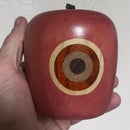Introduction: Used Book Puzzles
Old, used books, worn, but a shame to throw away - upcycle into beautiful jigsaw puzzles!
And what puzzles! Fiction, non-fiction, adventure, historical, multicultural, local authors... the breadth of published cover-art far outstrips commercial puzzles.
And for little cost! Used books are almost given away at most thrift stores and library book sales. Additionally, whole boxes of books (text books, missing pages, etc) are unfit for these resellers, and can be had for free.
Minutes of laser cutting turn beautiful old books into fantastic jigsaw puzzles... mysteries fit to be solved!
Step 1: Selecting Books
Select hardback covers with attractive layouts.
The art can increase or simplify the puzzle complexity. Clean, clear graphic layouts will be easier. Nature / repetitive patterns will be more difficult. Covers with large empty areas / solid blocks of color are problematic.
Any size will work. Keep in mind more pieces increase the challenge, but smaller pieces are less enjoyable to work with. Typical piece sizes (area) are
- 0.5in2 : Adult
- 1.0in2 : Adult Large Format
- 2.0in2 : Child
- 3.0in2 : Toddler
In practice, this seems to limit most book covers to children's puzzles (< 200 pcs). A 1000 piece adult puzzle would measure about 22" square, pushing the limits of available books.
Dulled covers will work. The lasered kerfs have a strong, dark aspect. This competes with a cover's clarity, thus mint condition is unnecessary.
However, not every book cover will cut into a good jigsaw puzzle. Flimsy / thin covers lack the body to interlock. Foam and puffy foam-stuffed covers may contain chemicals harmful to laser optics and should be avoided. Flaking or delaminating (bubbling) covers are prone to falling apart after lasering. Finally, the lack of pattern information can considerably increase the difficulty. Skip these unless the extra challenge is desired.
Step 2: Puzzle Cut Design
Via opencliart.org members roeschterand member yves_guillou have shared vector graphics for puzzles (manythanks!). Twelve tile-outs ranging from 25 to 1600 pieces pieces are available (see my puzzle collection at openclipart for all 12). Find a graphic with the number of pieces you want.
To work with the puzzle layout, I use Inkscape*, a free, open-source, vector graphics program. Physically measure your book cover and adjust the graphic (stretch / shrink) to the size of your book cover, minus a little bit. Removing this little bit will bring the cut into the cover, cutting the border all around. Pull the job layout just a tiny bit back from the laser bed edges, to bring the cut onto the entire cover.
Ensure all lines are thin enough to register as vector cuts. For Epilog machines use line width of < 0.100 pt.
The back cover can be used as a board to rest the completed puzzle on. Using the graphic, delete all lines except the border, and use this to cut the back cover to fit.
*Using Inkscape, there is a known problem communicating with some laser cutters. Vector cuts can not be communicated directly via the print menu, so the accepted workaround is to export the image file as a .pdf and send the print job from Adobe Acrobat Reader. (see "Printing to Laser cutter rasterizes images" for more background on this problem, comments #9 and #10 in particular.)
Step 3: Fire Up the Laser!
The Epilog Fusion 40 watt laser cutter vector settings are 5% speed, 100% power, 20% frequency. Using an Epilog Legend EX 120 watt laser settings are 50% speed, 15% power and 100% frequency.
Two notes: First, cover variance from publisher to publisher and wear difference from book to book cause different results. Second, the settings used above were never optimized. The 120 watt settings above produced a perfect cut (just barely connected pieces, ready to be separated) and several undercuts (only partial depth of cut) on different books.
Reduce failures with this workflow: Batch up similar covers (typically by published series). Use the back covers as first pass material to optimize the settings. Cut last the individual books with appreciable wear, again using the back cover to tweak the batch's settings. A little practice and you can get a good feel for adjusting.
To reduce smoke staining on the artwork, cut face down on the bed. Or cover faces in painters tape and remove after cutting (tedious, but very effective).
Carefully sliding a piece of sheet metal under the finished cut, lift the entire, completed puzzle off the cutting bed. Sandwich the puzzle with the back cover and flip over as whole, complete puzzle.
On the 40 watt machine, a 25 piece puzzle can be cut in ~7 minutes, a 315 piece puzzle can be cut in ~14 minutes. On the 120 watt machine, a 25 piece puzzle can be cut in ~2 minutes, a 315 piece puzzle can be cut in ~5 minutes.
Step 4: Cleanup and Put Away
The cutting will leave a char residue / dust on the faces. This can be wiped off with a slightly damp cloth.
Unfortunately laser cutting leaves burnt char in the kerfs. This will get kids fingers a bit dirty. It is possible to expel some of this using compressed air, but impossible to entirely remove. Young product-testers seem unconcerned. Their parents... that depends on the parents.
A great way to package the puzzles is fully assembled, resting on the back cover, in a snug bag. This gives the user a good look at how it looks completed.
These puzzles are great donations to local schools /children organizations, typically for 4-6 year old kids (25 piece puzzles). Children of that age are pretty hard on puzzles but fairly unconcerned with the used book wear. The organizations can inexpensively maintain a stock of puzzles for play time. The community benefits from the upcycling of local items, reducing many costs externalized in consumer puzzles. And of course everyone enjoys a book with a happy ending!




